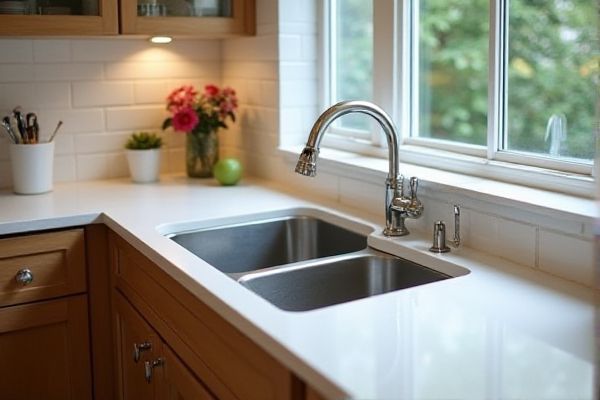
Utility sinks are designed for heavy-duty tasks like cleaning tools and handling large messes, while prep sinks are smaller, strategically placed in kitchens to facilitate food preparation and improve workflow. Discover which sink type best suits Your space and needs by reading the rest of the article.
Table of Comparison
| Feature | Utility Sink | Prep Sink |
|---|---|---|
| Primary Use | Heavy-duty cleaning, laundry, and messes | Food preparation and washing ingredients |
| Location | Laundry rooms, garages, basements | Kitchens, kitchen islands |
| Size | Larger and deeper for bulky items | Smaller and shallow for quick rinsing |
| Material | Durable materials like stainless steel or heavy plastic | Stainless steel, porcelain, or composite materials |
| Faucet Type | High-arc, pull-down sprayers for flexibility | Standard faucets focused on convenience |
| Drain System | Designed for debris and strong odors | Standard kitchen drain compatible |
| Price Range | Typically $150 - $400 | Typically $100 - $300 |
Overview: Utility Sink vs Prep Sink
A utility sink typically serves heavy-duty tasks such as cleaning large items, soaking laundry, or handling messy jobs, often found in laundry rooms or garages. A prep sink is smaller and designed primarily for food preparation tasks, enhancing kitchen workflow by providing an extra water source near cooking areas. Choosing between a utility sink and a prep sink depends on your household needs, space availability, and the primary function you require.
Key Functions and Purposes
Utility sinks serve primarily for heavy-duty cleaning tasks such as washing large items, soaking laundry, and managing messy projects, offering durability and capacity for utility purposes. Prep sinks are designed for food preparation, providing an additional water source near cooking areas to streamline washing fruits, vegetables, and utensils while enhancing kitchen workflow. Both sinks optimize kitchen efficiency but cater to distinct functions: utility sinks focus on cleaning and maintenance, whereas prep sinks enhance food prep convenience.
Design Differences
Utility sinks typically feature a deep basin with durable materials such as stainless steel or heavy-duty plastic designed for heavy cleaning tasks, while prep sinks often have shallower basins optimized for food preparation and washing produce. Utility sinks prioritize functionality with larger dimensions to accommodate bulky items and may include utility-specific features like built-in washboards or sprayers. Prep sinks are generally integrated into kitchen countertops, emphasizing compact design and ease of access to support efficient meal prepping workflows.
Size and Capacity Comparison
Utility sinks typically offer larger basin sizes, ranging from 20 to 30 inches in width and depths of up to 20 inches, designed to handle heavy-duty tasks such as cleaning large tools or soaking laundry. Prep sinks are generally smaller, averaging 15 to 20 inches wide with shallower depths around 6 to 10 inches, optimized for food preparation and quick rinsing without taking up significant countertop space. The larger capacity of utility sinks makes them ideal for multifunctional use, while prep sinks prioritize compactness and efficiency in kitchen workflows.
Material and Durability Considerations
Utility sinks are typically made from durable materials like stainless steel, cast iron, or heavy-duty plastic, designed to withstand rigorous use and resist stains, scratches, and chemicals. Prep sinks often feature materials such as stainless steel or granite composite, balancing durability with an upscale appearance suitable for food preparation areas. Your choice should consider both the wear resistance you need and the sink's compatibility with its intended environment to ensure long-term functionality.
Installation Locations
Utility sinks are typically installed in laundry rooms, garages, or basements where heavy-duty cleaning tasks or messier jobs require durable water access. Prep sinks are usually installed in kitchen areas or islands to facilitate food preparation, offering convenience and enhanced workflow within cooking spaces. Both sink types require proper plumbing connections but differ in placement based on their primary functions and surrounding activities.
Maintenance and Cleaning
Utility sinks are designed for heavy-duty cleaning tasks, making them more resistant to stains and easier to maintain when dealing with dirt, grease, or paint. Prep sinks are often smaller and more delicate, requiring regular cleaning to prevent buildup from food particles and soap scum, which can affect your kitchen's hygiene. Choosing the right sink for your space impacts how often you need to perform maintenance and the type of cleaning products you should use.
Cost Factors
Utility sinks generally cost less than prep sinks due to their simpler design and fewer installation requirements, often ranging from $100 to $400. Prep sinks, designed for kitchen use with features like additional faucets and integrated accessories, tend to cost between $300 and $1,000 or more depending on materials and complexity. Your choice should account for installation expenses, as prep sinks often require plumbing modifications that raise the overall cost compared to the more straightforward setup of utility sinks.
Pros and Cons of Each Sink Type
Utility sinks offer versatile deep basins ideal for heavy-duty cleaning and handling large items, but their bulky design may consume valuable space in smaller kitchens. Prep sinks enhance kitchen workflow with convenient placement for food preparation and quick rinsing, although they typically feature shallower basins that limit their use for heavy cleaning tasks. Choosing between a utility sink and a prep sink depends on the specific needs of the household, balancing space availability, desired functionality, and cleaning requirements.
Choosing the Right Sink for Your Needs
Utility sinks provide deep basins ideal for heavy-duty cleaning, laundry tasks, and handling large items, making them perfect for garages or laundry rooms. Prep sinks, typically smaller and installed in kitchens or bars, enhance meal preparation efficiency by offering additional workspace and easy access to water. Selecting the right sink depends on your specific activities, space availability, and the functional role you want the sink to play in your home.
 homyna.com
homyna.com